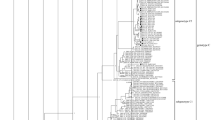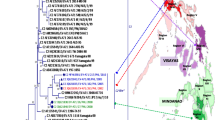Abstract
Echovirus 33 (E33) has been infrequently detected and is less frequently associated with clinical diseases when compared with other types of enteroviruses (EVs) in China. An outbreak of E33 was identified in four schools in Hunan Province, China, in June 2013. For laboratory diagnosis, throat swabs and/or serum specimens were collected from 27 patients. E33 was isolated in cell culture and typed by molecular methods. Complete VP1 gene sequences were determined and analyzed. Specific E33 antibody was measured by virus neutralization testing. From June 3-20, 108 suspected cases were reported, and 19 were confirmed to be associated with E33 by laboratory testing, with seven virologically confirmed and 12 serologically confirmed cases. The suspected cases were in children aged 3-16 years (mean, 11 years), most of whom (94 %, 102/108) were ≥6 years old. The majority of cases (98 %, 106/108) presented as influenza-like illness (ILI), and two were clinically diagnosed as viral meningitis. Older children aged ≥12 years had a higher hospitalization rate (21 %) than younger children (4 %). A BLAST query of GenBank with the Hunan E33 strain VP1 gene sequence gave a close match to an E33 isolate from Pakistan, based on a partial VP1 gene sequence. Phylogenetic analyses of the complete E33 VP1 gene sequences from our study revealed an independent cluster with nucleotide sequences that diverge from E33 from other countries by >12 %. Due to limited E33 VP1 gene sequence data in GenBank and passive EV surveillance in China and most other parts of the world (excepting hand, foot, and mouth disease surveillance in Asia), the approximate origin of Hunan E33 could not be determined.



Similar content being viewed by others
References
Aguilera JF, Paget WJ, Mosnier A, Heijnen ML, Uphoff H, van der Velden J, Vega T, Watson JM (2003) Heterogeneous case definitions used for the surveillance of influenza in Europe. Eur J Epidemiol 18:751–754
Bingjun T, Yoshida H, Yan W, Lin L, Tsuji T, Shimizu H, Miyamura T (2008) Molecular typing and epidemiology of non-polio enteroviruses isolated from Yunnan Province, the People’s Republic of China. J Med Virol 80:670–679
CDC (2010) Nonpolio enterovirus and human parechovirus surveillance–United States, 2006–2008. MMWR 59:1577–1580
Chang LY, King CC, Hsu KH, Ning HC, Tsao KC, Li CC, Huang YC, Shih SR, Chiou ST, Chen PY, Chang HJ, Lin TY (2002) Risk factors of enterovirus 71 infection and associated hand, foot, and mouth disease/herpangina in children during an epidemic in Taiwan. Pediatrics 109:e88
Ding ZR, Tang JJ, Tian BJ, Zhang J, Li LQ, Zhao ZX, He LF (2010) Status of enterovirus infection and molecular identification among healthy children at the areas bordering Myanmar, in Yunnan province, China. Zhonghua Liu Xing Bing Xue Za Zhi 31:185–188
Druyts-Voets E, Yane F, Bosmans E, Colaert J, Desmyter J (1985) Method for selecting optimal cells for enterovirus isolation as determined in an outbreak of echovirus type 33 meningitis. Eur J Clin Microbiol 4:331–334
Grimwood K, Huang QS, Sadleir LG, Nix WA, Kilpatrick DR, Oberste MS, Pallansch MA (2003) Acute flaccid paralysis from echovirus type 33 infection. J Clin Microbiol 41:2230–2232
Hall TA (1999) BioEdit: a user-friendly biological sequence alignment editor and analysis program for Windows 95/98/NT. Nucleic Acids Symp Ser 41:95–98
Huang G, Yu D, Zhu Z, Zhao H, Wang P, Gray GC, Meng L, Xu W (2013) Outbreak of febrile respiratory illness associated with human adenovirus type 14p1 in Gansu Province. Influ Other Respir Viruses, China. doi:10.1111/irv.12118
Huang QS, Carr JM, Nix WA, Oberste MS, Kilpatrick DR, Pallansch MA, Croxson MC, Lindeman JA, Baker MG, Grimwood K (2003) An echovirus type 33 winter outbreak in New Zealand. Clin Infect Dis 37:650–657
Kammerer PE, Montiel S, Kriner P, Bojorquez I, Bejarano Ramirez V, Vazquez-Erlbeck M, Azziz-Baumgartner E, Blair PJ, Hawksworth AW, Faix DJ, Nava ML, Lopez LW, Palacios E, Flores R, Fonseca-Ford M, Phippard A, Lopez K, Johnson J, Bustamante Moreno JG, Russell KL, Waterman SH (2012) Influenza-like illness surveillance on the California–Mexico border, 2004–2009. Influ Other Respir Viruses 6:358–366
Khetsuriani N, Lamonte-Fowlkes A, Oberst S, Pallansch MA (2006) Enterovirus surveillance–United States, 1970–2005. MMWR Surveill Summ 55:1–20
Khetsuriani N, Kutateladze T, Zangaladze E, Shutkova T, Penaranda S, Nix WA, Pallansch MA, Oberste MS (2010) High degree of genetic diversity of non-polio enteroviruses identified in Georgia by environmental and clinical surveillance, 2002–2005. J Med Microbiol 59:1340–1347
Kimura H, Minakami H, Sakae K, Ohbuchi M, Kuwashima M, Otsuki K (1997) Outbreak of echovirus type 33 infection in Japanese school children. Pediatr Infect Dis J 16:83–84
Knipe DM, Howley PM, Griffin DE, Lamb RA, Martin MA, Roizman B, Straus SE (2007) Fields virology, 5th edn. Lippincott Williams & Wilkins, Philadelphia
Knowles NJ, Hovi T, Hyypiä T, King AMQ, Lindberg AM, Pallansch MA, Palmenberg AC, Simmonds P, Skern T, Stanway G, Yamashita T, Zell R (2012) Virus taxonomy: classification and nomenclature of viruses: ninth report of the International Committee on Taxonomy of Viruses. Elsevier, San Diego
Kroneman A, Vennema H, Deforche K, v d Avoort H, Penaranda S, Oberste MS, Vinje J, Koopmans M (2011) An automated genotyping tool for enteroviruses and noroviruses. J Clin Virol 51:121–125
Kuramitsu M, Kuroiwa C, Yoshida H, Miyoshi M, Okumura J, Shimizu H, Narantuya L, Bat-Ochir D (2005) Non-polio enterovirus isolation among families in Ulaanbaatar and Tov province, Mongolia: prevalence, intrafamilial spread, and risk factors for infection. Epidemiol Infect 133:1131–1142
Lee MK, Chan PK, Ho II, Lai WM (2013) Enterovirus infection among patients admitted to hospital in Hong Kong in 2010: epidemiology, clinical characteristics, and importance of molecular diagnosis. J Med Virol 85:1811–1817
Mirand A, Henquell C, Archimbaud C, Chambon M, Charbonne F, Peigue-Lafeuille H, Bailly JL (2008) Prospective identification of enteroviruses involved in meningitis in 2006 through direct genotyping in cerebrospinal fluid. J Clin Microbiol 46:87–96
Oberste MS, Maher K, Kilpatrick DR, Pallansch MA (1999) Molecular evolution of the human enteroviruses: correlation of serotype with VP1 sequence and application to picornavirus classification. J Virol 73:1941–1948
Oberste MS, Maher K, Pallansch MA (2004) Evidence for frequent recombination within species human enterovirus B based on complete genomic sequences of all thirty-seven serotypes. J Virol 78:855–867
Oberste MS, Feeroz MM, Maher K, Nix WA, Engel GA, Hasan KM, Begum S, Oh G, Chowdhury AH, Pallansch MA, Jones-Engel L (2013) Characterizing the picornavirus landscape among synanthropic nonhuman primates in Bangladesh, 2007 to 2008. J Virol 87:558–571
Quillien MC, Baruteau R, Alix D, Lejeune B, Jehan P, Chastel C (1983) An epidemic of Echovirus 33 infection in Brittany. Ann Pediatr (Paris) 30:409–413
Rao CD, Yergolkar P, Shankarappa KS (2012) Antigenic diversity of enteroviruses associated with nonpolio acute flaccid paralysis, India, 2007–2009. Emerg Infect Dis 18:1833–1840
Rao DC, Ananda Babu M, Raghavendra A, Dhananjaya D, Kumar S, Maiya PP (2013) Non-polio enteroviruses and their association with acute diarrhea in children in India. Infect Genet Evol 17:153–161
Rosen L, Kern J (1965) Toluca-3, a newly recognized enterovirus. Proc Soc Exp Biol Med 118:389–391
Sadeuh-Mba SA, Bessaud M, Massenet D, Joffret ML, Endegue MC, Njouom R, Reynes JM, Rousset D, Delpeyroux F (2013) High frequency and diversity of species C enteroviruses in Cameroon and neighboring countries. J Clin Microbiol 51:759–770
Sato K, Yamashita T, Sakae K, Suzuki Y, Ishikawa N, Nishimura Y (1998) A new-born baby outbreak of echovirus type 33 infection. J Infect 37:123–126
Tamura K, Peterson D, Peterson N, Stecher G, Nei M, Kumar S (2011) MEGA5: molecular evolutionary genetics analysis using maximum likelihood, evolutionary distance, and maximum parsimony methods. Mol Biol Evol 28:2731–2739
Tan X, Huang X, Zhu S, Chen H, Yu Q, Wang H, Huo X, Zhou J, Wu Y, Yan D, Zhang Y, Wang D, Cui A, An H, Xu W (2011) The persistent circulation of enterovirus 71 in People’s Republic of China: causing emerging nationwide epidemics since 2008. PLoS One 6:e25662
Zhang Y, Wang J, Guo W, Wang H, Zhu S, Wang D, Bai R, Li X, Yan D, Wang H, Zhang Y, Zhu Z, Tan X, An H, Xu A, Xu W (2011) Emergence and transmission pathways of rapidly evolving evolutionary branch C4a strains of human enterovirus 71 in the Central Plain of China. PLoS One 6:e27895
Zhang Y, Zhu Z, Yang W, Ren J, Tan X, Wang Y, Mao N, Xu S, Zhu S, Cui A, Zhang Y, Yan D, Li Q, Dong X, Zhang J, Zhao Y, Wan J, Feng Z, Sun J, Wang S, Li D, Xu W (2008) An emerging recombinant human enterovirus 71 responsible for the, outbreak of hand foot and mouth disease in Fuyang city of China. Virol J 7:94
Zhu Z, Zhu S, Guo X, Wang J, Wang D, Yan D, Tan X, Tang L, Zhu H, Yang Z, Jiang X, Ji Y, Zhang Y, Xu W (2010) Retrospective seroepidemiology indicated that human enterovirus 71 and coxsackievirus A16 circulated wildly in central and southern China before large-scale outbreaks from 2008. Virol J 7:300
Acknowledgments
We thank all the staffs in Shimen prefectural CDC who conducted field investigations and collected the clinical specimens. We thank all the staffs in Changde municipal CDC and Hunan provincial CDC who participated or organized the emergency response to the outbreak. We also thank Dr. W. Allan Nix for the revision of the manuscript, Dr. M. Steven Oberste (US CDC) for helpful discussion of the manuscript, and Dr. Dustin C. Yang (US CDC) for modifying the manuscript. This work was supported by a grant of Key Technologies Research and Development Program from Ministry of Science and Technology (Grant numbers: 2013ZX10004-202, 2012ZX10004201-003).
Conflict of interest
All authors: No reported conflicts.
Author information
Authors and Affiliations
Corresponding author
Additional information
X. Tan, L. Gao, and X. Ma contributed equally to this work.
Electronic supplementary material
Below is the link to the electronic supplementary material.
Rights and permissions
About this article
Cite this article
Tan, X., Gao, L., Ma, X. et al. An outbreak of echovirus 33 in schools in China in 2013. Arch Virol 159, 2233–2241 (2014). https://doi.org/10.1007/s00705-014-2059-6
Received:
Accepted:
Published:
Issue Date:
DOI: https://doi.org/10.1007/s00705-014-2059-6




